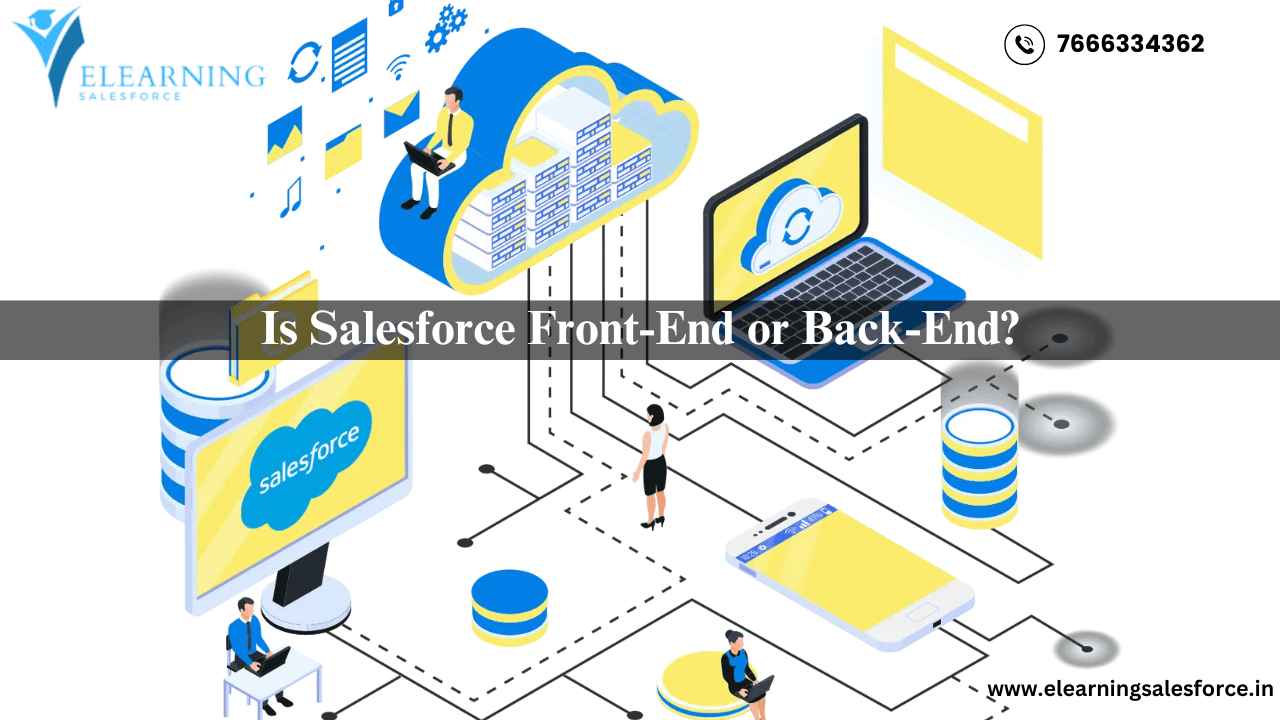Do you want to know if Salesforce is a back-end or front-end tool? Or perhaps you want to know how Salesforce relates to corporate software in general. You’ve come to the correct spot whether you’re new to Salesforce or a business trying to better grasp its function.
We’ll define Salesforce, go over its main features, and show you how it relates to the front-end vs. back-end controversy in this blog. We’ll also go over important market trends and how knowing Salesforce may help you succeed in the tech industry. Let’s get started!
What is Salesforce?
- It’s critical to comprehend the fundamentals of Salesforce before delving into whether it is front-end or back-end. The main purpose of Salesforce, a cloud-based software platform, is customer relationship management (CRM). It assists companies in tracking sales, managing client interactions, and improving customer service.
- Salesforce is much more than that, though! Salesforce provides a broad range of solutions that assist businesses in streamlining procedures and enhancing client interactions, from data analytics and app development to marketing automation.
Is Salesforce Front-End or Back-End?
Now, the big question: Is Salesforce a front-end or back-end tool?
To put it simply, Salesforce can be both. Because it provides both front-end and back-end functionality through its numerous products and services, it differs slightly from typical software tools. Let’s dissect it even more:
Salesforce as a Back-End Tool
Because it does the heavy work behind the scenes, particularly with regard to data management, client information, and process automation, Salesforce is most frequently regarded as a back-end platform. Salesforce, for instance, is used by companies to effectively manage and store enormous volumes of client data, monitor interactions, and conduct sales procedures. This is Salesforce’s back-end, or the operations that are necessary to keep things functioning but that users do not directly engage with.
- Salesforce CRM: Salesforce’s CRM is the foundation of the platform, gathering and storing information about leads, customers, and prospects. The “back-end” technology aids businesses in comprehending client behavior and customizing their offerings.
- Salesforce Automation Tools: Salesforce’s automation tools operate in the background to help businesses save time and resources by automating repetitive actions like sending emails and starting workflows.
Salesforce as a Front-End Tool
Salesforce contributes significantly to the front-end as well as the back-end. Here, people communicate with the system directly. Salesforce offers an adaptable user interface (UI) that enables staff members to interact with leads or clients, run reports, and access customer data.
- Salesforce Lightning Experience: Users can access a contemporary, dynamic experience using Salesforce’s front-end platform, Lightning. Business users can log in here to monitor marketing campaigns, manage sales pipelines, and check client accounts.
- With Salesforce Visualforce : developers can design unique user interfaces for the platform. Visualforce enables you to create bespoke apps or websites on top of the Salesforce platform.
In summary, depending on the sector you’re concentrating on, Salesforce can be both a front-end and a back-end tool. While the back-end handles data processing and business workflow automation, the front-end component lets users access and modify data.
Why is Salesforce So Important?
Understanding Salesforce is crucial because it’s widely adopted across industries. It’s more than just a tool – it’s a game changer for businesses looking to stay competitive. Here’s why:
- Business Automation
Salesforce increases the efficiency of company processes by automating repetitive procedures. By automating customer support follow-ups and sales workflows, it frees up staff members to concentrate on high-value activities. - Customization and Scalability
Salesforce is extremely beneficial because it can be scaled and tailored to meet unique business demands, regardless of the size of your company. With a variety of connections and add-ons, it can expand with your company. - Cloud-Based Flexibility
Salesforce may be accessible at any time and from any location because it is cloud-based. In the world of remote work today, this is particularly crucial. Teams and employees may access client data while on the road, which facilitates productivity and connection. - Market Demand for Salesforce Professionals
The need for experts who understand how to utilize and modify Salesforce is increasing as more companies implement the platform. Gaining knowledge of Salesforce can improve your employment prospects whether you’re a developer, marketing, or business analyst.
Real-World Example: Salesforce in Action
- Let’s examine a practical example: Salesforce’s CRM is used by Amazon Web Services (AWS), one of the largest cloud service providers globally, to monitor client contacts, streamline sales procedures, and enhance customer support. Amazon’s sales representatives may more easily customize offers and deliver a better customer experience by using the Salesforce platform to obtain real-time data into customer accounts.
- By leveraging both front-end and back-end tools within Salesforce, AWS ensures that their customer interactions are seamless and well-coordinated.
How Can You Get Started with Salesforce?
Now that you know Salesforce is both front-end and back-end, how can you get started with learning this valuable tool? Here are some practical tips:
- Start with the Basics:
Discover the fundamentals of CRM and the cloud platform functionality of Salesforce. Many free materials are available, such as Salesforce’s own Trailhead site, which provides interactive certifications and lessons. - Explore the Salesforce Ecosystem:
Learn more about Salesforce’s various products, including Visualforce, Salesforce Lightning, and Einstein, its AI-powered analytics tool. Gaining an understanding of these elements will improve your comprehension of Salesforce’s front-end and back-end features. - Get Certified:
Consider being certified if you’re serious about a career in Salesforce. From administrator to developer, Salesforce provides a range of credentials that can increase your marketability and reputation in the workplace. - Practice by Building:
Using Salesforce is the greatest method to learn it, just like using any other software application! Try creating a Salesforce sandbox and experimenting with its capabilities if you can. Build custom reports, create dashboards, and explore the user interface.
Conclusion: Take the Leap into Salesforce
- Therefore, is Salesforce back-end or front-end? It’s both! Salesforce offers all the tools you need to manage client data, automate business procedures, and create unique user interfaces. You’re not just learning a platform when you start using Salesforce; you’re preparing yourself for success in a world that is becoming more and more digital.
- Are you prepared to advance your Salesforce expertise? Start your journey to become an expert in Salesforce by looking through our advanced learning materials. Salesforce is at the forefront of the cloud revolution!
Odata in sap abap step by step – Technicalgyanguru
SAP vs Oracle Which ERP Software is the Winner?




